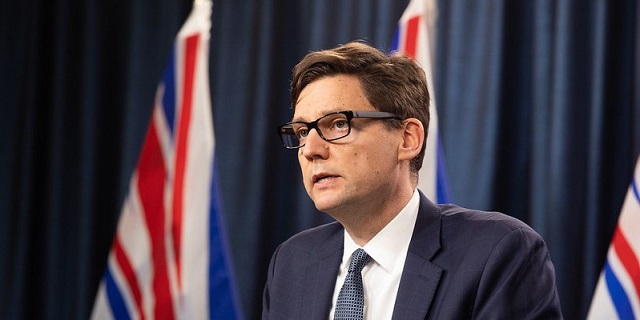Health
B.C. government sends patients to U.S. while fighting private options in B.C.

From the Fraser Institute
By Mackenzie Moir and Bacchus Barua
Among universal health-care countries, after adjusting for age, Canada ranked highest for health-care spending as a percentage of the economy in 2021 (the latest year of available comparable data). The problem is how we do universal health care
The recent ordeal of Allison Ducluzeau, a wife and mother from Victoria who spent more than $200,000 out of pocket to seek life-saving cancer treatment in the United States, has been widely shared on social media. Unfortunately, Ducluzeau’s story is not unique.
According to Second Street, a Canadian research organization, Canadians made approximately 217,500 trips abroad to seek health care in 2017, long before the pandemic (and related health-care backlogs and delays). To understand why this happens within our universal system, simply look at the data. In 2023, Canadians could expect a median wait of 27.7 weeks between referral to treatment across 12 medically-necessary specialities. In B.C., patients had to wait four weeks to see an oncologist, and another 5.9 weeks for treatment. In fact, the total wait between referral to treatment for oncology in B.C. (9.9 weeks) is now about twice as long as the Canadian average (4.8 weeks).
Moreover, the Canadian Institute for Health Information reported last year that, among provinces, B.C. was the second-worst performer in the country in meeting the national benchmark for radiation therapy (that is, receiving treatment within four weeks after seeing a specialist).
Why is this happening? Why do B.C. patients face such daunting wait times for potentially life-saving treatment?
For starters, compared to its universal health-care peers, Canada has fewer medical resources available. After adjusting for population age differences among high-income universal health-care countries, Canada ranked 28th (out of 30 countries) for the availability of doctors, 23rd (of 29) for hospital beds, 26th (of 30) for CT scanners and 19th (of 26) for PET scanner availability.
In response to B.C.’s long delays for cancer care, the Eby government recently instituted a cross-border initiative that sends patients to Washington State for treatment. Although this is good news for some patients, it’s not a long-term solution to our health-care woes. And this selective and short-term initiative is cold comfort to patients suffering from other medical conditions and who remain without local options as they endure long delays for medically-necessary care. Indeed, Allison Ducluzeau needed chemotherapy and could not take advantage of this initiative.
To be clear, Canada’s relative dearth of resources and long wait times are not due to inadequate funding. Among universal health-care countries, after adjusting for age, Canada ranked highest for health-care spending as a percentage of the economy in 2021 (the latest year of available comparable data). The problem is how we do universal health care. Unlike Canada, most other universal health-care countries fund their hospitals according to activity levels to incentivize treatment. And they understand that the private sector is a valuable partner in their universal health-care frameworks.
For defenders of the status quo, private involvement in the financing and delivery of health care within our borders remains out of the question. In fact, the same Eby government that sends B.C. patients across the border for care has fought against private options in B.C. And you can be sure that PeaceHealth St. Joseph Cancer Center and the North Cascade Cancer Center in Washington State—where the Eby government is sending cancer patients—will not be subject to the same limitations the Eby government imposes on private clinics in B.C.
If the provincial government is unable to deliver timely access to care through our publicly-funded health-care system, it should allow patients to pay privately for alternatives within our borders. By forcing patients such as Allison Ducluzeau to leave their loved ones and travel abroad to receive life-saving treatment, our policymakers yet again cling to a stubborn and failed approach to universal health care.
Authors:
Business
Prime minister can make good on campaign promise by reforming Canada Health Act

From the Fraser Institute
While running for the job of leading the country, Prime Minister Carney promised to defend the Canada Health Act (CHA) and build a health-care system Canadians can be proud of. Unfortunately, to have any hope of accomplishing the latter promise, he must break the former and reform the CHA.
As long as Ottawa upholds and maintains the CHA in its current form, Canadians will not have a timely, accessible and high-quality universal health-care system they can be proud of.
Consider for a moment the remarkably poor state of health care in Canada today. According to international comparisons of universal health-care systems, Canadians endure some of the lowest access to physicians, medical technologies and hospital beds in the developed world, and wait in queues for health care that routinely rank among the longest in the developed world. This is all happening despite Canadians paying for one of the developed world’s most expensive universal-access health-care systems.
None of this is new. Canada’s poor ranking in the availability of services—despite high spending—reaches back at least two decades. And wait times for health care have nearly tripled since the early 1990s. Back then, in 1993, Canadians could expect to wait 9.3 weeks for medical treatment after GP referral compared to 30 weeks in 2024.
But fortunately, we can find the solutions to our health-care woes in other countries such as Germany, Switzerland, the Netherlands and Australia, which all provide more timely access to quality universal care. Every one of these countries requires patient cost-sharing for physician and hospital services, and allows private competition in the delivery of universally accessible services with money following patients to hospitals and surgical clinics. And all these countries allow private purchases of health care, as this reduces the burden on the publicly-funded system and creates a valuable pressure valve for it.
And this brings us back to the CHA, which contains the federal government’s requirements for provincial policymaking. To receive their full federal cash transfers for health care from Ottawa (totalling nearly $55 billion in 2025/26) provinces must abide by CHA rules and regulations.
And therein lies the rub—the CHA expressly disallows requiring patients to share the cost of treatment while the CHA’s often vaguely defined terms and conditions have been used by federal governments to discourage a larger role for the private sector in the delivery of health-care services.
Clearly, it’s time for Ottawa’s approach to reflect a more contemporary understanding of how to structure a truly world-class universal health-care system.
Prime Minister Carney can begin by learning from the federal government’s own welfare reforms in the 1990s, which reduced federal transfers and allowed provinces more flexibility with policymaking. The resulting period of provincial policy innovation reduced welfare dependency and government spending on social assistance (i.e. savings for taxpayers). When Ottawa stepped back and allowed the provinces to vary policy to their unique circumstances, Canadians got improved outcomes for fewer dollars.
We need that same approach for health care today, and it begins with the federal government reforming the CHA to expressly allow provinces the ability to explore alternate policy approaches, while maintaining the foundational principles of universality.
Next, the Carney government should either hold cash transfers for health care constant (in nominal terms), reduce them or eliminate them entirely with a concordant reduction in federal taxes. By reducing (or eliminating) the pool of cash tied to the strings of the CHA, provinces would have greater freedom to pursue reform policies they consider to be in the best interests of their residents without federal intervention.
After more than four decades of effectively mandating failing health policy, it’s high time to remove ambiguity and minimize uncertainty—and the potential for politically motivated interpretations—in the CHA. If Prime Minister Carney wants Canadians to finally have a world-class health-care system then can be proud of, he should allow the provinces to choose their own set of universal health-care policies. The first step is to fix, rather than defend, the 40-year-old legislation holding the provinces back.
COVID-19
FDA requires new warning on mRNA COVID shots due to heart damage in young men

From LifeSiteNews
Pfizer and Moderna’s mRNA COVID shots must now include warnings that they cause ‘extremely high risk’ of heart inflammation and irreversible damage in males up to age 24.
The Trump administration’s Food and Drug Administration (FDA) announced it will now require updated safety warnings on mRNA COVID-19 shots to include the “extremely high risk” of myocarditis/pericarditis and the likelihood of long-term, irreversible heart damage for teen boys and young men up to age 24.
The required safety updates apply to Comirnaty, the mRNA COVID shot manufactured by Pfizer Inc., and Spikevax, the mRNA COVID shot manufactured ModernaTX, Inc.
According to a press release, the FDA now requires each of those manufacturers to update the warning about the risks of myocarditis and pericarditis to include information about:
- the estimated unadjusted incidence of myocarditis and/or pericarditis following administration of the 2023-2024 Formula of mRNA COVID-19 shots and
- the results of a study that collected information on cardiac magnetic resonance imaging (cardiac MRI) in people who developed myocarditis after receiving an mRNA COVID-19 injection.
The FDA has also required the manufacturers to describe the new safety information in the adverse reactions section of the prescribing information and in the information for recipients and caregivers.
Additionally, the fact sheets for healthcare providers and for recipients and caregivers for Moderna COVID-19 shot and Pfizer-BioNTech COVID-19 shot, which are authorized for emergency use in individuals 6 months through 11 years of age, have also been updated to include the new safety information in alignment with the Comirnaty and Spikevax prescribing information and information for recipients and caregivers.
In a video published on social media, Dr. Vinay Prasad, director of the Center for Biologics Evaluation & Research Chief Medical and Scientific Officer, explained the alarming reasons for the warning updates.
While heart problems arose in approximately 8 out of 1 million persons ages 6 months to 64 years following reception of the cited shots, that number more than triples to 27 per million for males ages 12 to 24.
Prasad noted that multiple studies have arrived at similar findings.
-

 Alberta2 days ago
Alberta2 days agoAlberta Next: Immigration
-

 COVID-191 day ago
COVID-191 day agoFDA requires new warning on mRNA COVID shots due to heart damage in young men
-

 Business1 day ago
Business1 day agoCarney’s new agenda faces old Canadian problems
-

 Alberta Sports Hall of Fame and Museum2 days ago
Alberta Sports Hall of Fame and Museum2 days agoAlberta Sports Hall of Fame 2025 Inductee Profiles – Para Nordic Skiing – Brian and Robin McKeever
-

 Crime1 day ago
Crime1 day agoNews Jeffrey Epstein did not have a client list, nor did he kill himself, Trump DOJ, FBI claim
-

 Bruce Dowbiggin1 day ago
Bruce Dowbiggin1 day agoEau Canada! Join Us In An Inclusive New National Anthem
-

 International16 hours ago
International16 hours agoChicago suburb purchases childhood home of Pope Leo XIV
-

 Daily Caller16 hours ago
Daily Caller16 hours agoBlackouts Coming If America Continues With Biden-Era Green Frenzy, Trump Admin Warns








